Domestic Quarter Horse (Equus caballus) Milk Macronutrient Composition Analyses Within Micro Quantities from Two Different Geographical Locations
Simple Summary
Abstract
1. Introduction
2. Materials and Methods
3. Results
4. Discussion
5. Conclusions
Author Contributions
Funding
Institutional Review Board Statement
Informed Consent Statement
Data Availability Statement
Acknowledgments
Conflicts of Interest
Abbreviations
| NC | North Carolina |
| CA | California |
| DMB | dry matter basis |
| GE | gross energy |
References
- Frantz, L.A.F.; Bradley, D.G.; Larson, G.; Orlando, L. Animal Domestication in the Era of Ancient Genomics. Nat. Rev. Genet. 2020, 21, 449–460. [Google Scholar] [CrossRef] [PubMed]
- Petersen, J.L.; Mickelson, J.R.; Rendahl, A.K.; Valberg, S.J.; Andersson, L.S.; Axelsson, J.; Bailey, E.; Bannasch, D.; Binns, M.M.; Borges, A.S.; et al. Genome-Wide Analysis Reveals Selection for Important Traits in Domestic Horse Breeds. PLoS Genet. 2013, 9, e1003211. [Google Scholar] [CrossRef] [PubMed]
- Taş Gürsoy, İ. Horse-Drawn Carriages: Sustainability at the Nexus of Human-Animal Interaction. J. Sustain. Tour. 2020, 28, 204–221. [Google Scholar] [CrossRef]
- Crossman, G.K.; Walsh, R. The Changing Role of the Horse: From Beast of Burden to Partner in Sport and Recreation. Int. J. Sport Soc. 2011, 2, 95–110. [Google Scholar] [CrossRef]
- Stull, C.L. The Journey to Slaughter for North American Horses. Anim. Front. 2012, 2, 68–71. [Google Scholar] [CrossRef]
- Franco, D.; Crecente, S.; Vázquez, J.A.; Gómez, M.; Lorenzo, J.M. Effect of cross breeding and amount of finishing diet on growth parameters, carcass and meat composition of foals slaughtered at 15 months of age. Meat Sci. 2013, 93, 547–556. [Google Scholar] [CrossRef]
- Salimei, E.; Fantuz, F. Equid Milk for Human Consumption. Int. Dairy J. 2012, 24, 130–142. [Google Scholar] [CrossRef]
- Numpaque, M.; Şanlı, T.; Anli, E.A. Diversity of Milks Other Than Cow, Sheep, Goat and Buffalo: In Terms of Nutrition and Technological Use. Turk. J. Agric. Food Sci. Technol. 2019, 7, 2047–2053. [Google Scholar] [CrossRef]
- Faye, B.; Konuspayeva, G. The Sustainability Challenge to the Dairy Sector—The Growing Importance of Non-Cattle Milk Production Worldwide. Int. Dairy J. 2012, 24, 50–56. [Google Scholar] [CrossRef]
- Spaulding, C.E. The Complete Care of Baby Animals; Skyhorse Publishing: New York, NY, USA, 2011; pp. 24–38. [Google Scholar]
- Cymbaluk, N.F.; Smart, M.E.; Bristol, F.M.; Pouteaux, V.A. Importance of Milk Replacer Intake and Composition in Rearing Orphan Foals. Can. Vet. J. 1993, 34, 479–486. Available online: https://pmc.ncbi.nlm.nih.gov/articles/PMC1686398/ (accessed on 20 February 2024).
- Milk Testing Services|Dairy One. Available online: https://dairyone.com/services/dhia-record-milk-analysis/milk-testing-services/ (accessed on 20 February 2024).
- Peterson, A.B.; French, K.R.; Russek-Cohen, E.; Kohn, R.A. Comparison of Analytical Methods and the Influence of Milk Components on Milk Urea Nitrogen Recovery. J. Dairy Sci. 2004, 87, 1747–1750. [Google Scholar] [CrossRef] [PubMed]
- Skibiel, A.L.; Downing, L.M.; Orr, T.J.; Hood, W.R. The Evolution of the Nutrient Composition of Mammalian Milks. J. Anim. Ecol. 2013, 82, 1254–1264. [Google Scholar] [CrossRef] [PubMed]
- Sayler, Z. What Aardvark Milk Reveals About the Evolution of Lactation. Smithsonian Magazine. 21 March 2018. Available online: https://www.smithsonianmag.com/smithsonian-institution/what-aardvark-milkreveals-about-evolution-lactation-180968523/ (accessed on 26 September 2024).
- Nebel, R.L.; McGilliard, M.L. Interactions of High Milk Yield and Reproductive Performance in Dairy Cows. J. Dairy Sci. 1993, 76, 3257–3268. [Google Scholar] [CrossRef] [PubMed]
- Hood, W.R.; Voltura, M.B.; Oftedal, O.T. Methods of Measuring Milk Composition and Yield in Small Mammals. In Ecological and Behavioral Methods for the Study of Bats; Johns Hopkins University Press: Baltimore, MD, USA, 2009; pp. 529–553. [Google Scholar]
- DuBois, M.; Gilles, K.A.; Hamilton, J.K.; Rebers, P.A.; Smith, F. Colorimetric Method for Determination of Sugars and Related Substances. Anal. Chem. 1956, 28, 350–356. [Google Scholar] [CrossRef]
- Biggs, D.A. Milk Analysis with the Infrared Milk Analyzer. J. Dairy Sci. 1967, 50, 799–803. [Google Scholar] [CrossRef]
- Laben, R.C. Factors Responsible for Variation in Milk Composition. J. Dairy Sci. 1963, 46, 1293–1301. [Google Scholar] [CrossRef]
- Ahmedsham, M.; Amza, N.; Tamiru, M. Review on Milk and Milk Product Safety, Quality Assurance and Control. Int. J. Livest. Prod. 2018, 9, 67–78. [Google Scholar] [CrossRef]
- Marier, J.; Boulet, M. Direct Analysis of Lactose in Milk and Serum. J. Dairy Sci. 1959, 42, 1390–1391. [Google Scholar] [CrossRef]
- Petzinger, C.; Oftedal, O.T.; Jacobsen, K.; Murtough, K.L.; Irlbeck, N.A.; Power, M.L. Proximate Composition of Milk of the Bongo (Tragelaphus eurycerus) in Comparison to Other African Bovids and to Hand-Rearing Formulas. Zoo Biol. 2014, 33, 305–313. [Google Scholar] [CrossRef]
- Musaev, A.; Sadykova, S.; Anambayeva, A.; Saizhanova, M.; Balkanay, G.; Kolbaev, M. Mare’s Milk: Composition, Properties, and Application in Medicine. Arch. Razi Inst. 2021, 76, 1125–1135. [Google Scholar] [CrossRef]
- Wells, S.; Ferwerda, N.; Timms, L.L. Evaluation of Mare Milk Composition/Quality during Lactation. Iowa State Univ. Anim. Ind. Rep. 2012, 9, 51–53. [Google Scholar] [CrossRef]
- Potočnik, K.; Gantner, V.; Kuterovac, K.; Cividini, A. Mare’s Milk: Composition and Protein Fraction in Comparison with Different Milk Species. Mljek. Čas. Unapr. Proizv. Prerade Mlijeka 2011, 61, 107–113. [Google Scholar]
- Hoffman, R.M.; Kronfeld, D.S.; Herbein, J.H.; Swecker, W.S.; Cooper, W.L.; Harris, P.A. Dietary Carbohydrates and Fat Influence Milk Composition and Fatty Acid Profile of Mare’s Milk. J. Nutr. 1998, 128, 2708S–2711S. [Google Scholar] [CrossRef] [PubMed]
- Pieszka, M.; Łuszczyński, J.; Szeptalin, A. Comparison of mare’s milk composition of different breeds. Nauka Przyr. Technol. 2011, 5, 112. [Google Scholar]
- Doreau, M.; Boulot, S.; Martin-Rosset, W. Effect of Parity and Physiological State on Intake, Milk Production and Blood Parameters in Lactating Mares Differing in Body Size. Anim. Sci. 1991, 53, 111–118. [Google Scholar] [CrossRef]
- Syrstad, O. Effects of twinning on milk production in dairy cattle. Livest. Prod. Sci. 1977, 4, 255–261. [Google Scholar] [CrossRef]
- Markiewicz-Kęszycka, M.; Czyżak-Runowska, G.; Wójtowski, J.; Jóźwik, A.; Pankiewicz, R.; Łęska, B.; Bagnicka, E. Influence of stage of lactation and year season on composition of mares’ colostrum and milk and method and time of storage on vitamin C content in mares’ milk. J. Sci. Food Agric. 2015, 95, 2279–2286. [Google Scholar] [CrossRef]
- Doreau, M.; Boulot, S.; Chilliard, Y. Yield and Composition of Milk from Lactating Mares: Effect of Body Condition at Foaling. J. Dairy Res. 1993, 60, 457–466. [Google Scholar] [CrossRef]
- Martono SNegara, W.; Gopar, R.A.; Rofiq, M.N. Combination effect of feed supplements on milk yield and milk quality of dairy cattle. J. Adv. Agric. Technol. 2016, 3, 136–139. [Google Scholar] [CrossRef]
- Derisoud, E.; Auclair-Ronzaud, J.; Rousseau-Ralliard, D.; Philau, S.; Aujean, E.; Durand, A.; Chavatte-Palmer, P. Maternal Age, Parity and Nursing Status at Fertilization Affects Postpartum Lactation Up to Weaning in Horses. J. Equine Vet. Sci. 2023, 128, 104868. [Google Scholar] [CrossRef]
- Nielsen, N.I.; Larsen, T.; Bjerring, M.; Ingvartsen, K.L. Quarter health, milking interval, and sampling time during milking affect the concentration of milk constituents. J. Dairy Sci. 2005, 88, 3186–3200. [Google Scholar] [CrossRef] [PubMed]
- Assan, N. Influence of suckling and/or milking method on yield and milk composition in dairy animals. Sci. J. Zool. 2015, 4, 1–7. [Google Scholar]
- D’Alessandro, A.G.; Martemucci, G. Lactation curve and effects of milking regimen on milk yield and quality, and udder health in Martina Franca jennies (Equus asinus). J. Anim. Sci. 2012, 90, 669–681. [Google Scholar] [CrossRef] [PubMed]
- Auclair-Ronzaud, J.; Jaffrézic, F.; Wimel, L.; Dubois, C.; Laloë, D.; Chavatte-Palmer, P. Estimation of milk production in suckling mares and factors influencing their milk yield. Animal 2022, 16, 100498. [Google Scholar] [CrossRef]
- National Research Council. Nutrient Requirements of Horses, 6th Revised ed.; The National Academies Press: Washington, DC, USA, 2007; pp. 1–6. [Google Scholar]
- Chirgin, E.D.; Onegov, A.V.; Strelnikov, A.I.; Holodova, L.V.; Novoselova, K.S. Changes in milk yield, fat and protein mass fractions in mares’ milk within 24 hours. IOP Conf. Ser. Earth Environ. Sci. 2019, 315, 042046. [Google Scholar] [CrossRef]
- Gibbs, P.G.; Potter, G.D.; Blake, R.W.; Mcmullan, A. Milk Production of Quarter Horse During 150 Days of Lactation. J. Anim. Sci. 1982, 3, 496–499. [Google Scholar] [CrossRef]
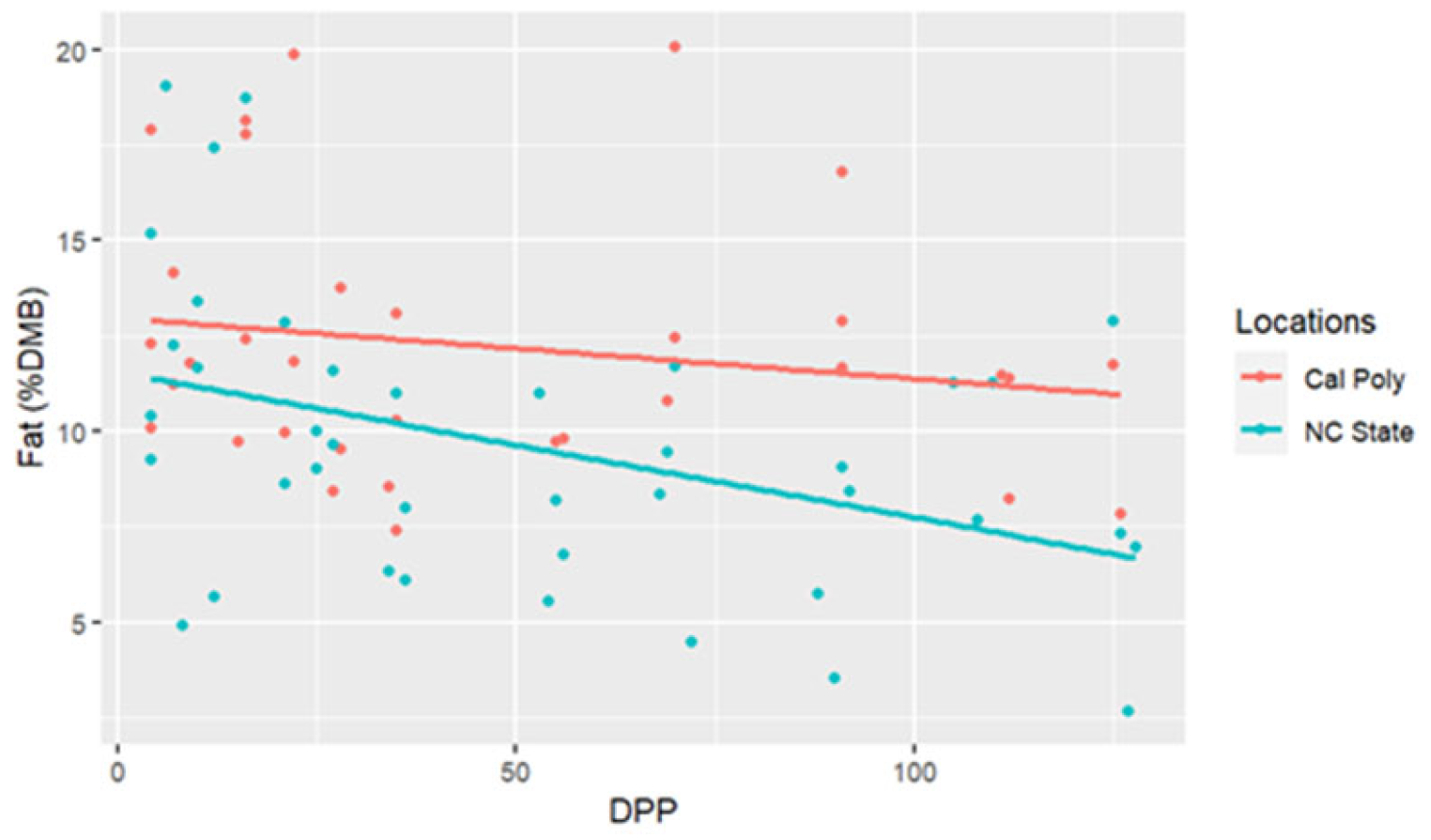
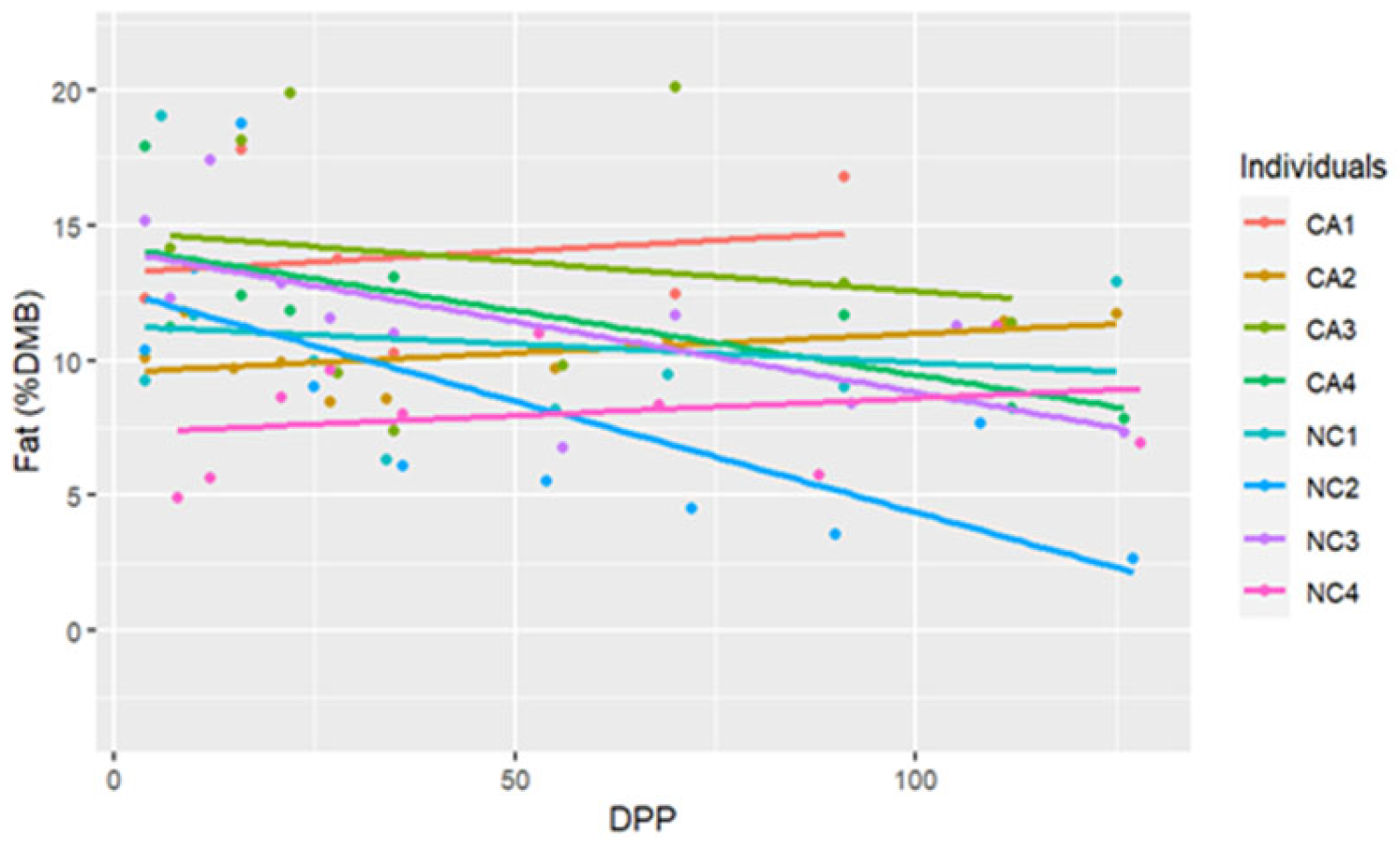
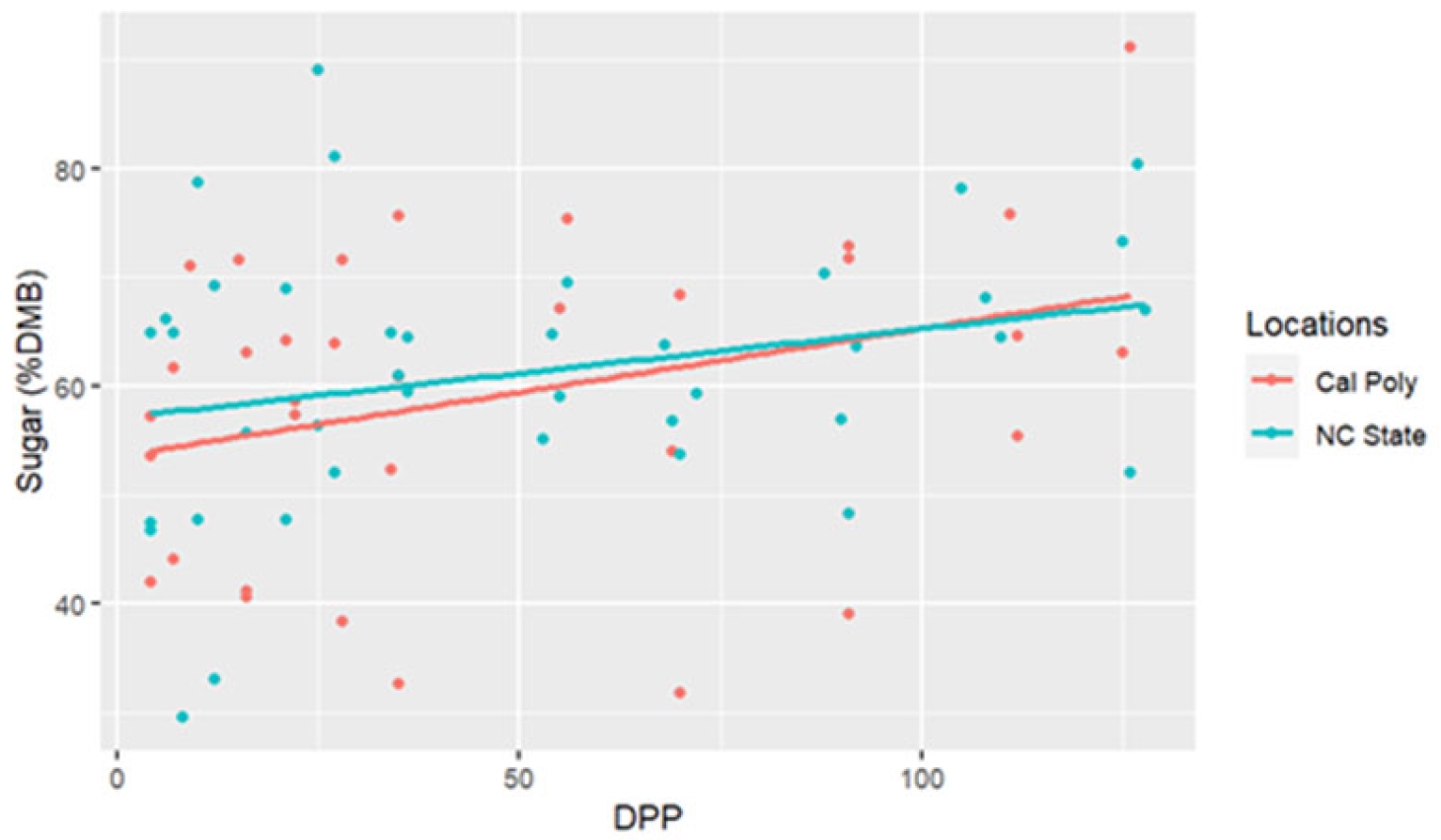
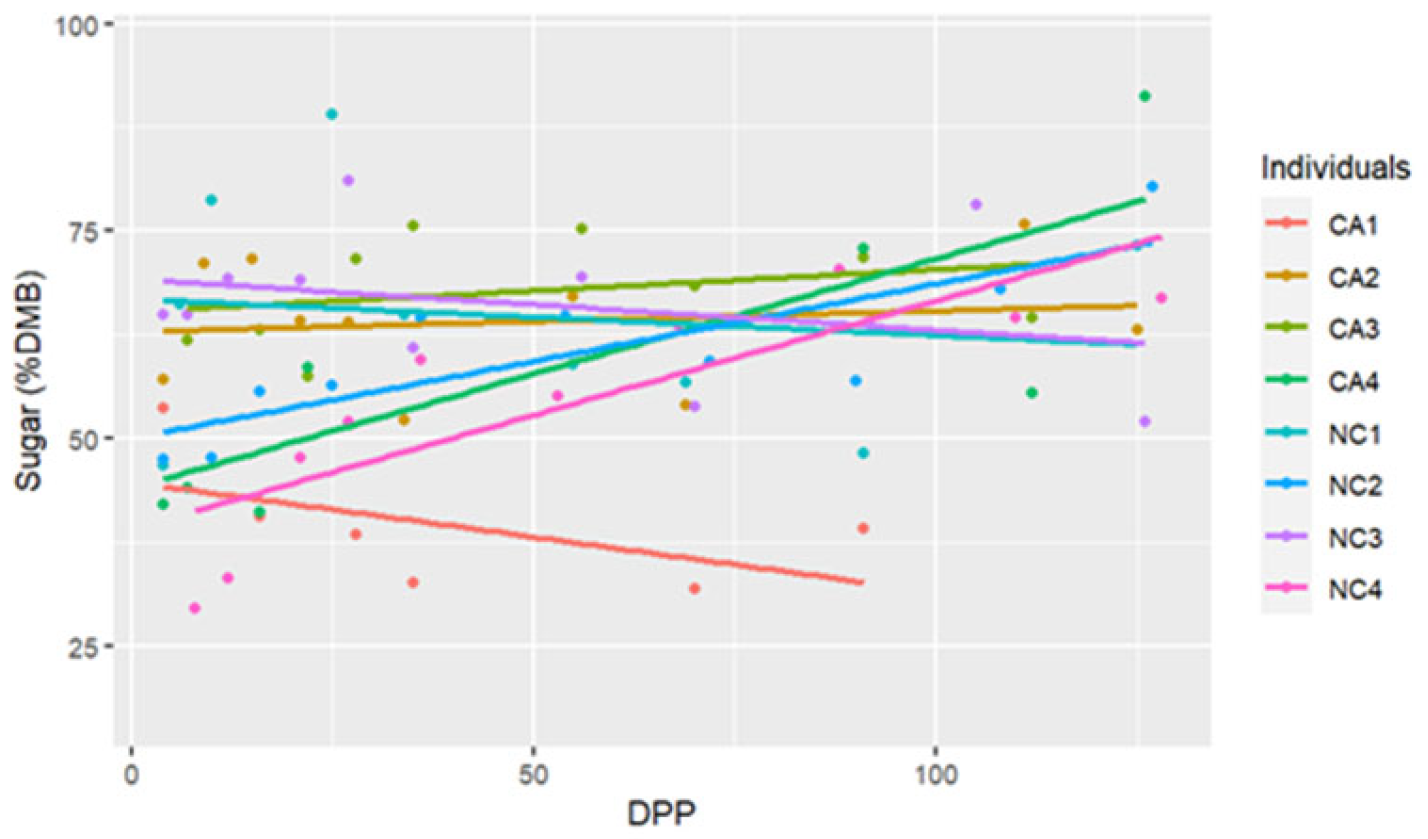
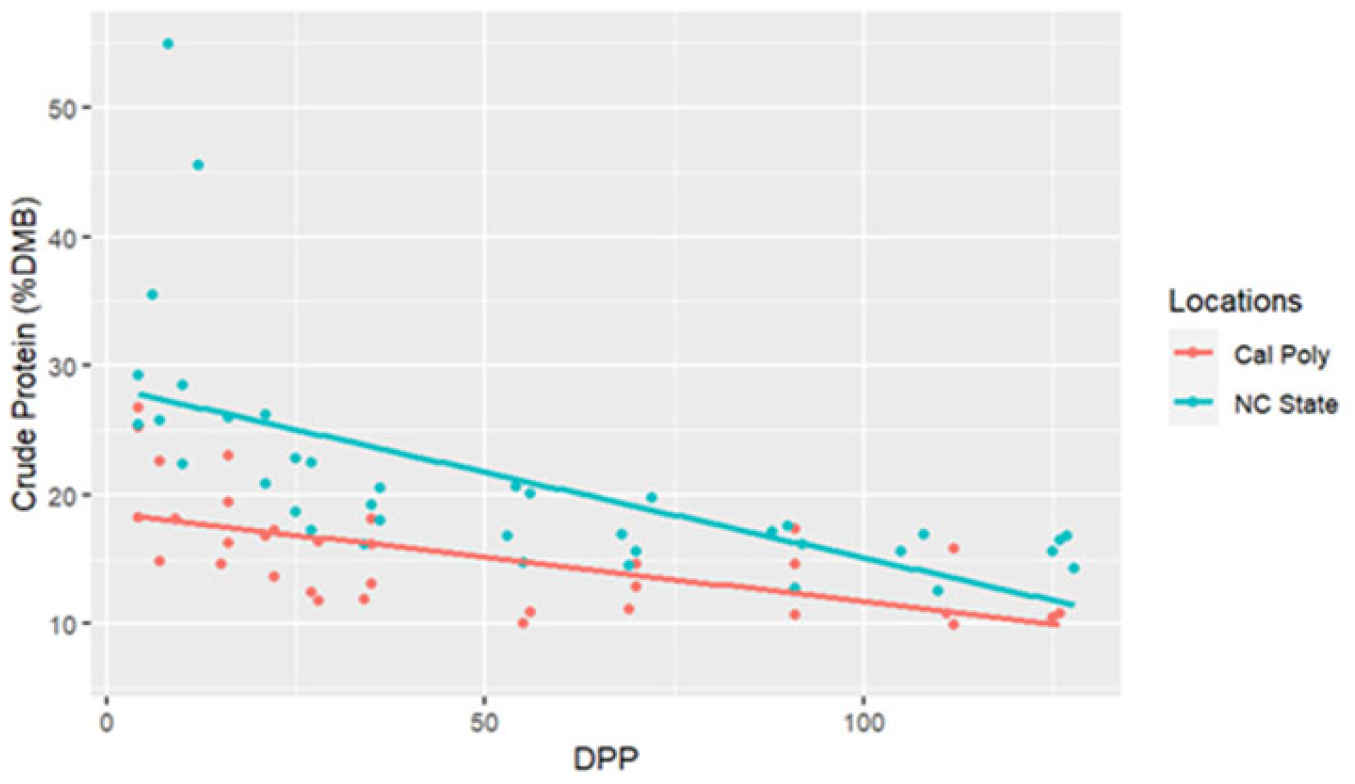
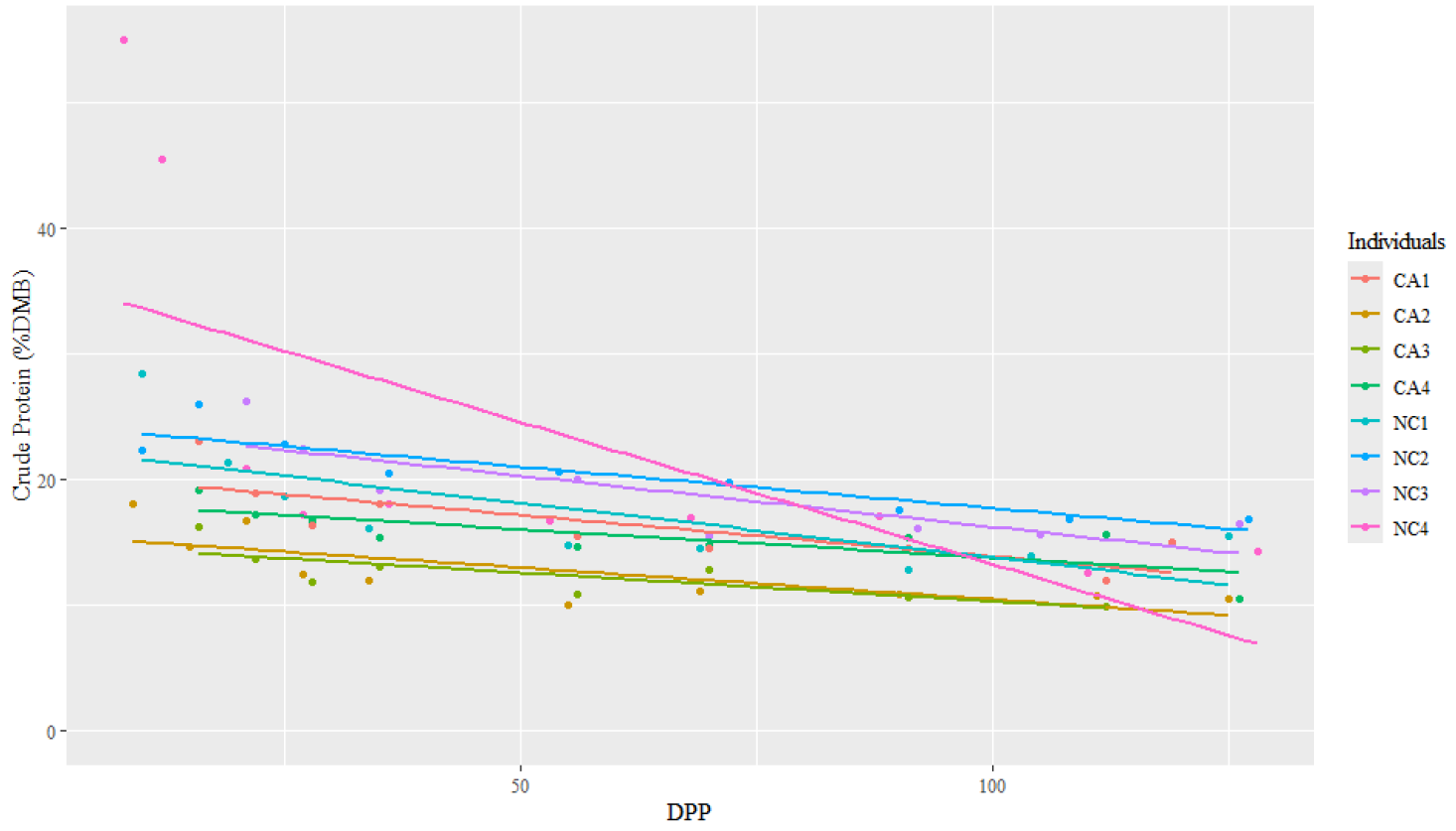
| Individuals | DPP | n |
|---|---|---|
| CA1 | 4–119 | 11 |
| CA2 | 4–125 | 11 |
| CA3 | 4–112 | 10 |
| CA4 | 4–126 | 11 |
| NC1 | 4–125 | 11 |
| NC2 | 4–127 | 10 |
| NC3 | 4–126 | 11 |
| NC4 | 4–128 | 10 1 |
| Dry Matter | Sugar | Protein * | Fat * | Ash | Gross Energy | |||||
|---|---|---|---|---|---|---|---|---|---|---|
| % | Fresh | DMB | Fresh | DMB | Fresh | DMB | Fresh | DMB | Kcal/g | |
| Average | 11.09 | 6.63 | 60.36 | 2.35 | 20.65 | 1.20 | 10.77 | 0.41 | 3.69 | 50.89 |
| NC | 11.27 | 6.85 | 61.35 | 2.90 | 25.01 | 1.08 | 9.58 | 0.45 | 3.96 | 53.90 |
| CA | 10.86 | 6.36 | 59.16 | 1.68 | 15.37 | 1.34 | 12.20 | 0.37 | 3.36 | 47.26 |
Disclaimer/Publisher’s Note: The statements, opinions and data contained in all publications are solely those of the individual author(s) and contributor(s) and not of MDPI and/or the editor(s). MDPI and/or the editor(s) disclaim responsibility for any injury to people or property resulting from any ideas, methods, instructions or products referred to in the content. |
© 2025 by the authors. Licensee MDPI, Basel, Switzerland. This article is an open access article distributed under the terms and conditions of the Creative Commons Attribution (CC BY) license (https://creativecommons.org/licenses/by/4.0/).
Share and Cite
Wagner, J.C.P.; Edwards, M.; Trivedi, S.; Minter, L.J.; Ange-van Heugten, K. Domestic Quarter Horse (Equus caballus) Milk Macronutrient Composition Analyses Within Micro Quantities from Two Different Geographical Locations. Animals 2025, 15, 882. https://doi.org/10.3390/ani15060882
Wagner JCP, Edwards M, Trivedi S, Minter LJ, Ange-van Heugten K. Domestic Quarter Horse (Equus caballus) Milk Macronutrient Composition Analyses Within Micro Quantities from Two Different Geographical Locations. Animals. 2025; 15(6):882. https://doi.org/10.3390/ani15060882
Chicago/Turabian StyleWagner, Jenna C. P., Mark Edwards, Shweta Trivedi, Larry J. Minter, and Kimberly Ange-van Heugten. 2025. "Domestic Quarter Horse (Equus caballus) Milk Macronutrient Composition Analyses Within Micro Quantities from Two Different Geographical Locations" Animals 15, no. 6: 882. https://doi.org/10.3390/ani15060882
APA StyleWagner, J. C. P., Edwards, M., Trivedi, S., Minter, L. J., & Ange-van Heugten, K. (2025). Domestic Quarter Horse (Equus caballus) Milk Macronutrient Composition Analyses Within Micro Quantities from Two Different Geographical Locations. Animals, 15(6), 882. https://doi.org/10.3390/ani15060882







